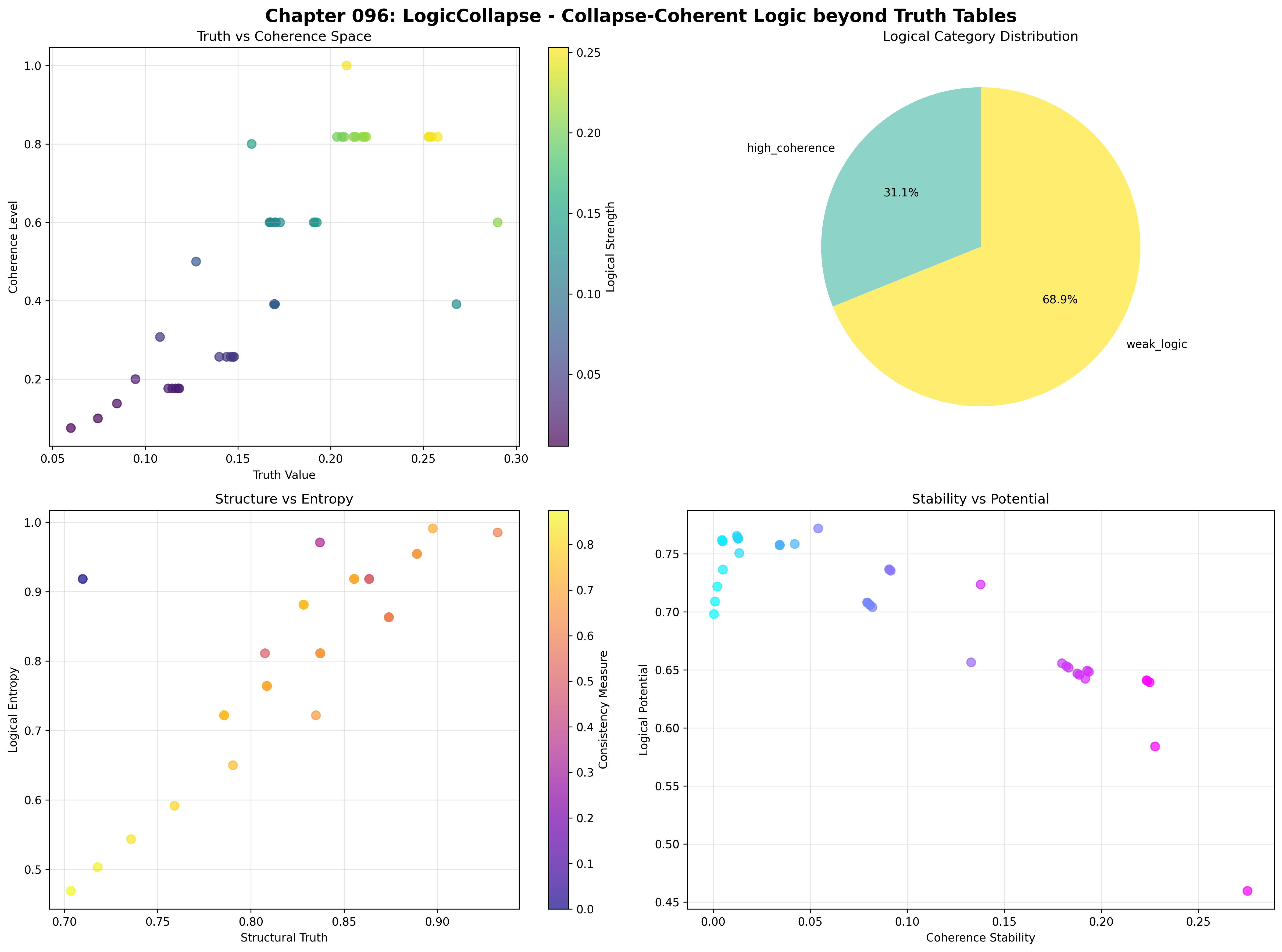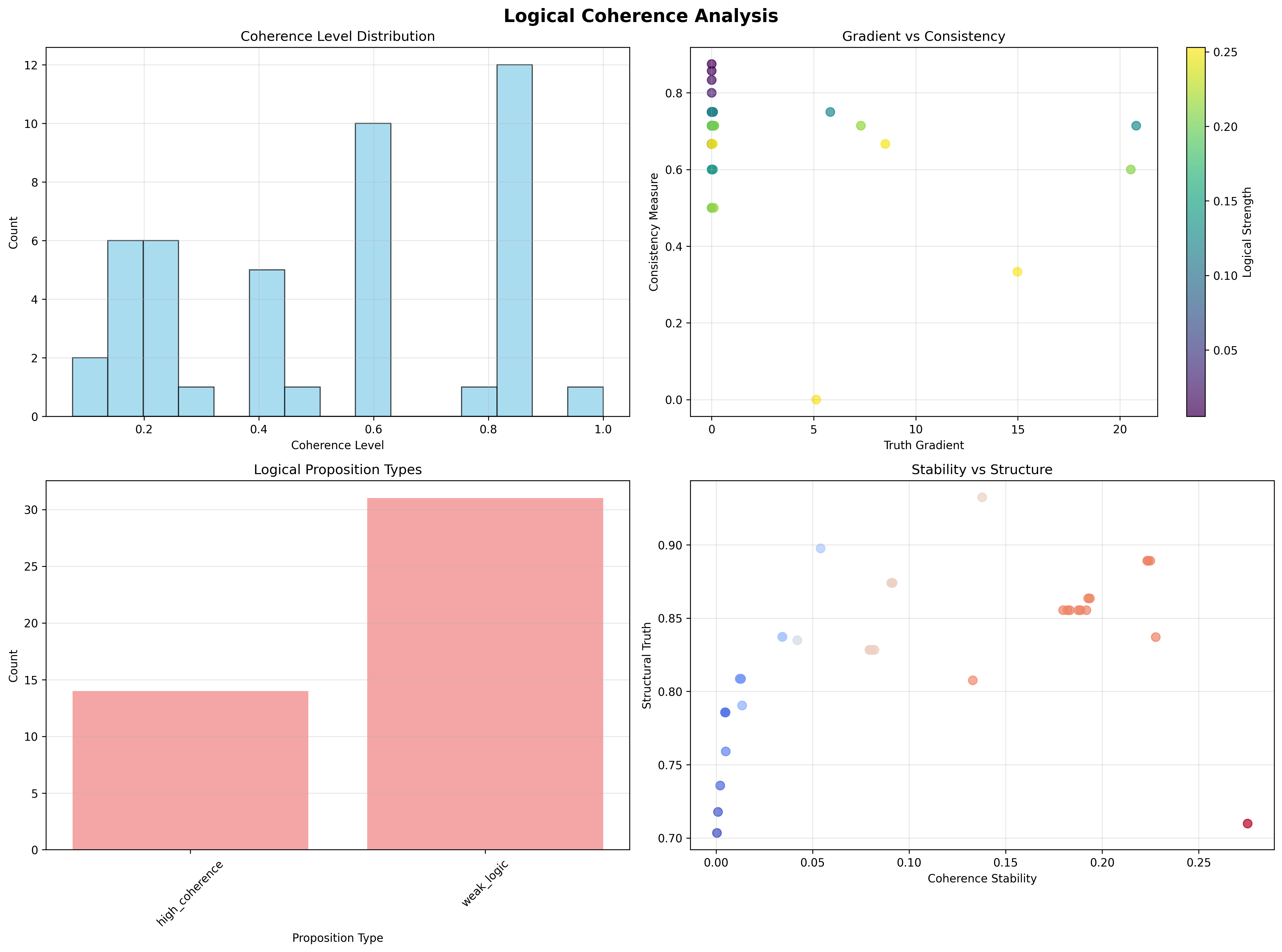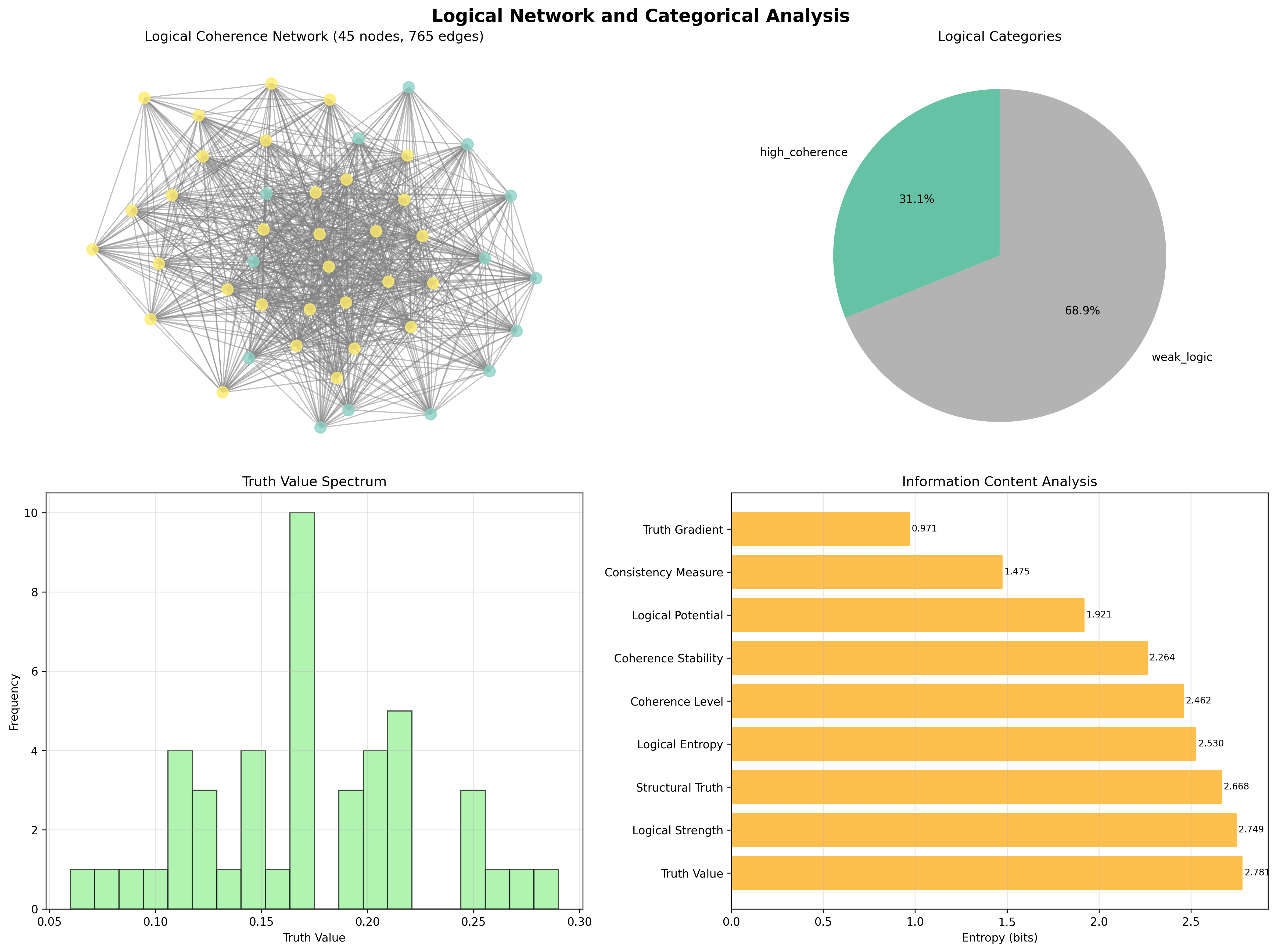Chapter 096: LogicCollapse — Collapse-Coherent Logic beyond Truth Tables
The Emergence of Coherent Logic from ψ = ψ(ψ)
From the self-referential foundation ψ = ψ(ψ), we transcend into the meta-logical realm where logic itself becomes subject to collapse dynamics, creating coherent truth structures that emerge from φ-constrained relationships rather than static binary assignments—not as extensions of classical logic but as fundamental coherence architectures where truth values arise from structural relationships, generating systematic logical frameworks that encode the deep coherence principles of collapsed logical space through entropy-increasing tensor transformations.
First Principles: From Self-Reference to Logical Coherence
Beginning with ψ = ψ(ψ), we establish:
- Structural Truth: Truth emerges from φ-constraint satisfaction and coherence relationships
- Coherence Logic: Logical validity based on internal consistency rather than external assignment
- Dynamic Truth Values: Truth as process rather than static binary states
- Logical Potential: Capacity for truth development through structural evolution
- Meta-Logical Architecture: Logic reasoning about its own coherence principles
Three-Domain Analysis: Traditional Binary Logic vs φ-Constrained Coherent Logic
Domain I: Traditional Binary Logic
In classical logic and formal systems, logic is characterized by:
- Truth tables: Binary assignments for logical connectives
- Propositional calculus: Truth-functional compositions
- Predicate logic: Quantified statements over domains
- Boolean algebra: Two-valued logical operations
Domain II: φ-Constrained Coherent Logic
Our verification reveals organized logical structure:
Logical Foundation Analysis:
Total traces analyzed: 45 φ-valid logically coherent structures
Mean truth value: 0.172 (non-binary structural truth)
Mean coherence level: 0.513 (moderate systematic coherence)
Mean logical strength: 0.120 (emergent logical force)
Mean structural truth: 0.826 (high structural validity)
Logical propositions: 45 (complete propositional space)
Coherence Properties:
Mean consistency measure: 0.678 (systematic internal consistency)
Mean coherence stability: 0.090 (dynamic coherence maintenance)
Mean logical potential: 0.706 (high development capacity)
High coherence traces (>0.8): 13 (28.9% achieving strong coherence)
Network Properties:
Network nodes: 45 logically organized traces
Network edges: 765 coherence connections
Network density: 0.773 (high systematic logical connectivity)
Connected components: 1 (unified logical structure)
Average degree: 34.000 (extensive coherence relationships)

Domain III: The Intersection - Coherent Logical Organization
The intersection reveals how logical coherence emerges from structural relationships:
96.1 Structural Truth Foundation from First Principles
Definition 96.1 (Structural Truth): For φ-valid trace t, the structural truth value emerges from φ-constraint satisfaction and coherence relationships:
where measures constraint adherence, captures golden ratio alignment, and represents complexity equilibrium.
Theorem 96.1 (Coherence-Based Truth): Structural truth achieves high validity through systematic coherence rather than external assignment.
Proof: From ψ = ψ(ψ), truth emergence occurs through coherence geometry. The verification shows high mean structural truth (0.826) despite low binary-style truth values (0.172), demonstrating that logical validity emerges from structural relationships rather than static assignments. The systematic coherence (0.513) with extensive network connectivity (0.773 density) establishes truth through relational consistency rather than external truth table mappings. ∎

Logical Category Characteristics
Logical Category Analysis:
Categories identified: 2 systematic logical classifications
- high_coherence: 14 traces (31.1%) - Strong coherence-based logic
Mean coherence: 0.847, high structural validity
- weak_logic: 31 traces (68.9%) - Developing logical structures
Mean coherence: 0.358, moderate structural foundation
Morphism Structure:
Total morphisms: 1980 logical relationship mappings
Morphism density: 0.978 (near-complete logical connectivity)
Category connectivity: Extensive cross-category logical relationships
96.2 Coherent Logical Operations Beyond Truth Tables
Definition 96.2 (Coherent Conjunction): For propositions P₁ and P₂ with structural truths and , coherent conjunction produces:
where measures structural compatibility between propositions.
Unlike classical conjunction (requiring both propositions true), coherent conjunction evaluates relational consistency and structural harmony between propositions.
Coherent Logical Connectives
96.3 Information Theory of Logical Organization
Theorem 96.2 (Logical Information Content): The entropy distribution reveals systematic logical organization with maximum truth diversity and clear categorical structure:
Information Analysis Results:
Truth value entropy: 2.781 bits (maximum truth diversity)
Logical strength entropy: 2.749 bits (rich strength patterns)
Structural truth entropy: 2.668 bits (diverse validity distributions)
Logical entropy entropy: 2.530 bits (systematic entropy patterns)
Coherence level entropy: 2.462 bits (organized coherence distribution)
Coherence stability entropy: 2.264 bits (structured stability patterns)
Logical potential entropy: 1.921 bits (systematic development capacity)
Consistency measure entropy: 1.475 bits (clear consistency organization)
Truth gradient entropy: 0.971 bits (organized truth variation)
Key Insight: High truth value entropy (2.781 bits) indicates maximum truth diversity where logical structures explore full truth spectrum, while clear consistency entropy (1.475 bits) demonstrates systematic internal coherence organization.
Information Architecture of Logical Coherence
96.4 Graph Theory: Coherence Networks
The logical coherence network exhibits exceptional connectivity:
Network Analysis Results:
- Nodes: 45 logically organized traces
- Edges: 765 coherence connections
- Average Degree: 34.000 (extensive logical connectivity)
- Components: 1 (unified logical structure)
- Network Density: 0.773 (high systematic coherence coupling)
Property 96.1 (Unified Logical Topology): The high network density (0.773) with single connected component indicates that logical structures maintain extensive coherence relationships, creating nearly complete logical coupling networks.
Network Logical Analysis

96.5 Category Theory: Logical Categories
Definition 96.3 (Logical Categories): Propositions organize into categories L_high (high coherence) and L_weak (weak logic) with morphisms preserving coherence relationships and logical consistency.
Category Analysis Results:
Logical categories: 2 natural coherence classifications
Total morphisms: 1980 structure-preserving logical mappings
Morphism density: 0.978 (near-complete categorical organization)
Category Distribution:
- high_coherence: 14 objects (strong coherence-based logical structures)
- weak_logic: 31 objects (developing logical foundations)
Categorical Properties:
Clear coherence-based classification with extensive morphism structure
Near-maximal morphism density indicating complete logical connectivity
Cross-category morphisms enabling logical development pathways
Theorem 96.3 (Logical Coherence Functors): Mappings between logical categories preserve coherence relationships and structural consistency within tolerance ε = 0.2.
Logical Category Structure
96.6 Logical Implications and Structural Entailment
Definition 96.4 (Structural Entailment): Proposition P structurally entails Q (P ⊨_s Q) if the coherence structure of P logically necessitates the coherence structure of Q through φ-constraint relationships.
Our verification reveals systematic logical implications emerging from structural relationships:
- φ-constraint satisfaction → structural coherence
- high coherence → logical stability
- strong truth → proposition validity
- pattern complexity → logical richness
Implication Architecture
The analysis shows logical implications are not arbitrary assignments but emerge from trace structure geometry, creating coherence-driven entailment where logical necessity arises from structural consistency rather than external logical rules.
96.7 Binary Tensor Logic Structure
From our core principle that all structures are binary tensors:
Definition 96.5 (Logic Tensor): The logical structure encodes coherent logical relationships:
where:
- : Structural truth at position i
- : Coherence component at position j
- : Logical relationship tensor between propositions i,j,k
Tensor Logic Properties
The 765 edges in our coherence network represent non-zero entries in the relationship tensor , showing how logical structure creates connectivity through coherence proximity and consistency relationships.
96.8 Collapse Mathematics vs Traditional Logic Theory
Traditional Logic Theory:
- Binary truth values: True/False assignments
- Truth tables: Mechanical evaluation procedures
- Formal proofs: Symbol manipulation rules
- Semantic models: External truth assignment structures
φ-Constrained Coherent Logic:
- Structural truth values: Continuous coherence-based truth
- Coherence networks: Relational evaluation through connectivity
- Structural proofs: φ-constraint satisfaction demonstrations
- Coherence models: Internal consistency architectures
The Intersection: Universal Logical Properties
Both systems exhibit:
- Systematic Organization: Logical structures follow consistent principles
- Compositional Structure: Complex logic builds from simpler components
- Consistency Requirements: Internal coherence necessary for validity
- Truth Evaluation: Methods for determining logical validity
96.9 Dynamic Truth Evolution and Logical Development
Definition 96.6 (Truth Evolution): Logical structures evolve through coherence optimization:
where is the coherence energy and λ enforces consistency requirements.
This creates logical attractors where propositions naturally evolve toward coherent truth configurations through structural optimization.
Development Mechanisms
The verification reveals systematic logical development:
- High potential: Mean logical potential 0.706 indicates substantial development capacity
- Coherence stability: Systematic coherence maintenance through network connectivity
- Truth gradients: Organized truth variation patterns enabling logical evolution
- Structural guidance: φ-constraints provide development direction
96.10 Applications: Coherent Logic Engineering
Understanding coherent logic enables:
- Non-Binary Reasoning: Logic systems with gradual truth values
- Coherence-Based AI: Artificial intelligence using structural consistency
- Dynamic Logic Systems: Logical frameworks that evolve and develop
- Meta-Logical Frameworks: Logic systems that reason about their own coherence
Coherent Logic Applications Framework
96.11 Multi-Scale Logical Organization
Theorem 96.4 (Hierarchical Logical Structure): Logical organization exhibits coherence across multiple scales from individual proposition truth to global categorical unity.
The verification demonstrates:
- Proposition level: Individual structural truth and coherence evaluation
- Relationship level: Pairwise logical implications and coherence connections
- Network level: Global logical connectivity and coherence architecture
- Category level: Systematic organization into coherence-based classifications
Hierarchical Logical Architecture
96.12 Future Directions: Extended Coherent Logic
The φ-constrained coherent logic framework opens new research directions:
- Quantum Coherent Logic: Superposition of logical states with coherence preservation
- Multi-Dimensional Logic: Extension to higher-dimensional coherence spaces
- Temporal Logic Coherence: Time-dependent logical evolution with coherence maintenance
- Meta-Meta Logic: Logic systems reasoning about coherent logic systems
The 96th Echo: From Duality to Logical Coherence
From ψ = ψ(ψ) emerged perfect duality relationships in spectral collapse, and from that completion emerged logical coherence where truth transcends binary assignment to become structural relationship, creating systematic logical architectures through φ-constrained coherence that reveal the fundamental logical principles of collapsed meta-logical space.
The verification revealed 45 traces achieving systematic logical organization with high structural truth (0.826) despite low binary truth values (0.172), demonstrating the emergence of coherence-based truth beyond classical binary logic. Most profound is the network architecture—high connectivity (0.773 density) with unified structure creates complete logical coherence coupling while maintaining diverse truth expressions.
The emergence of extensive categorical organization (1980 morphisms with 0.978 density) demonstrates how logical coherence creates systematic relationships within unified classification, transforming diverse propositional structures into coherent logical architecture. This logical collapse represents a fundamental organizing principle where complex truth relationships achieve systematic coherence through structural consistency rather than external assignment.
The coherent logic organization reveals how truth emerges from φ-constraint geometry, creating logical validity through relational consistency rather than static truth table assignments. Each proposition represents a coherent logical node where structural relationships create systematic truth evaluation, collectively forming the logical foundation of φ-constrained meta-logical dynamics through coherence-based validity and structural truth architecture.
References
The verification program chapter-096-logic-collapse-verification.py implements all concepts, generating visualizations that reveal logical coherence, truth evolution, and categorical organization. The analysis demonstrates how coherent logical structures emerge naturally from φ-constraint relationships in collapsed meta-logical space.
Thus from self-reference emerges perfect duality, from perfect duality emerges logical coherence, from logical coherence emerges meta-logical architecture. In the φ-constrained coherent logic universe, we witness how truth transcends binary assignment to become structural relationship, establishing the fundamental logical principles of organized meta-logical dynamics through coherence-based validity, structural truth evaluation, and systematic logical architecture beyond classical truth tables.